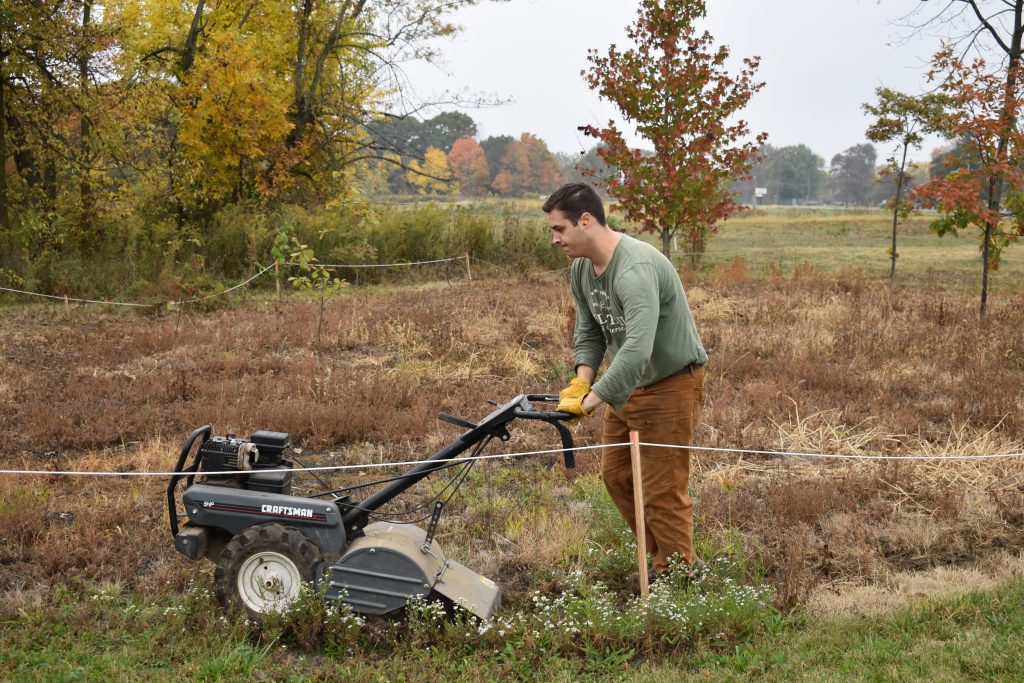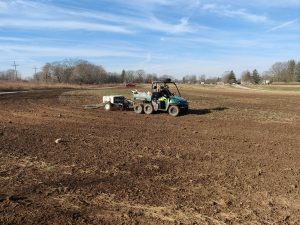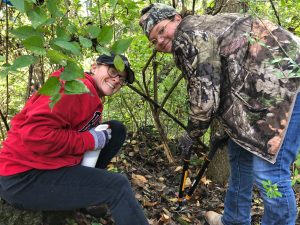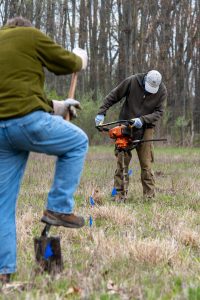
Once land is protected, stewardship plays a critical role in restoring habitats back to health or maintaining a pristine natural area.
Stewardship can come in many forms, but the goal is to provide or restore the biodiversity which supports all levels of the ecosystem. The amount and duration of stewardship is different for each nature preserve, but includes removing invasive species, planting native species, clearing trash, and planned burns of our grasslands.
Stewardship plans are developed for Red-tail’s protected natural areas. Below are some of our current projects which are in progress thanks to our supporters, partners, and volunteers.
Click Below to Explore Current Red-tail Conservation Projects
 McVey Memorial Forest – McVey Memorial Forest is located off Highway 1 north of Farmland, IN. This 249-acre woodland is the largest that Red-tail manages. Maturing woodlands, floodplains, riparian river corridors, and a small prairie makes this preserve support and incredible biodiversity of plants and wildlife. Because of this, Red-tail is developing a restoration Master Plan to ensure that this natural area is stewarded to the best of our ability. The Master Plan will provide a roadmap to guide the use of the land to support rare, threatened and endangered wildlife and outdoor recreation.
McVey Memorial Forest – McVey Memorial Forest is located off Highway 1 north of Farmland, IN. This 249-acre woodland is the largest that Red-tail manages. Maturing woodlands, floodplains, riparian river corridors, and a small prairie makes this preserve support and incredible biodiversity of plants and wildlife. Because of this, Red-tail is developing a restoration Master Plan to ensure that this natural area is stewarded to the best of our ability. The Master Plan will provide a roadmap to guide the use of the land to support rare, threatened and endangered wildlife and outdoor recreation.
The first phase of the plan is expected to be completed by Fall 2022. In the meantime, Red-tail is addressing certain tasks to jump start on future plans. Frequent visitors may have noticed the closing of specific trails, replacement of benches, and the removal of a bridge. All of which are puzzle pieces in the much larger continuing restoration efforts of McVey. This preserve is, and will continue to be, a place that nourishes wildlife and people.
Hidden Canal Nature Preserve – Established in January 2021, Hidden Canal Nature Preserve (HCNP) is a 50-acre forest nestled on the west bluff of the White River. Standing on the river bank you can see migratory waterfowl, signs of beaver, and tracks of otters. This floodplain forest protects the scenic view of its neighbor across the river, Mounds State Park, and provides critical habitat connectivity for wildlife.
However, connecting habitats is not this preserve’s only contribution to the natural world. As the name suggests, Hidden Canal Nature Preserve conceals the historical remnants of a man-made canal that never went fully operational. This is an interesting part of Madison County’s history that Red-tail intends to highlight by constructing trails to observe the canal remnants, while also providing visitors with interpretive signage to explain context. Learn more about the history by viewing HCNP’s introduction video.

The restorative efforts for this site are two-fold: showcase historical significance and improve habitat quality. HCNP has not had active habitat management conducted prior to Red-tail being involved. Many invasive plant species have claimed the woods. Removing these ecological threats and replacing them with native species is critical for HCNP. In the coming years, this site will be a unique experience for visitors to come and directly observe history while admiring the natural beauty surrounding them.
Because of ongoing, extensive restoration efforts, Hidden Canal Nature Preserve is closed to the public.
Dutro-Ernst Woods – Dutro-Ernst Woods is located within Muncie city limits on Highway 32. Once the site of a plant nursery, this 33-acre urban preserve sat fallow and unmanaged for nearly 40 years before Red-tail acquired the preserve.

Now, it is home to Red-tail’s most recent prairie restoration project. During the winter dormant season of 2020, the eastern portion of this preserve was planted with a diverse mixture of native prairie seeds. This seeding followed years of preparing the natural area to remove decades of noxious weeds and their seeds. Mowing, discing, and spraying were all part of a multi-step process of best practices for restoration success.
Beginning in 2021, the prairie will be mowed at a height of 6-8 inches for three years to allow our native plants to establish a dense, competitive root system within the soil. After this period of time, the prairie will be put on a long-term disturbance schedule, as native prairies need regular, intense disturbance like planned fires and mowing to maintain healthy plant communities.
The western section of Dutro-Ernst Woods will be managed and maintained differently than its prairie counterpart. As the former site of a plant nursery, the nature preserve became an invasive plant species hotspot. Removing invasive plants like honeysuckle, white mulberry, and garlic mustard and replacing them with native trees and shrubs will create a healthy, resilient ecosystem for the future.
Through volunteers, contracting work, and Red-tail’s staff, the goal of a beautiful hardwood forest will become a reality.
Munsee Woods – Situated west of Prairie Creek Reservoir, the 47-acre Munsee Woods is a former Girl Scout camp turned nature preserve. Acquired by Red-tail in April of 2011, Munsee Woods became Delaware County’s first dedicated state nature preserve and has been used as a gathering place for education and outdoor recreation ever since.
 Though not open to the public, Munsee Woods hosts programs in the former Girl Scout lodge. Management on this preserve looks slightly different from other Red-tail natural areas due to its potential for events and outreach. Maintaining buildings, improving visitor amenities, and removing old Scout infrastructure are all part of the ongoing management in order to engage the community.
Though not open to the public, Munsee Woods hosts programs in the former Girl Scout lodge. Management on this preserve looks slightly different from other Red-tail natural areas due to its potential for events and outreach. Maintaining buildings, improving visitor amenities, and removing old Scout infrastructure are all part of the ongoing management in order to engage the community.
Though Munsee Woods is one of the only Red-tail nature preserves with visitor facilities, most of the work done is to provide healthier habitats. Munsee Woods includes majestic older woods, wetlands, and streams. There is an ongoing effort to remove invasive plant species with the support of volunteers. To couple this extensive removal, tree plantings are regularly conducted to improve the woodlands.

Reber Woods – Reber Woods is located in north west Muncie. Some of the preserve is a prime example of a wetland forest and contains a rare heron rookery. However, half of the natural area was converted into an agricultural field. Red-tail acquired the woods in 2018 and has since been managing the field in an effort to restore it back to a wetland forest. Stewardship has been done through invasive plant species removal and annual tree plantings. A portion of the field under the powerline easement is being seeded with native prairie grasses and wildflowers.
Reforesting the field will not only create new habitat, but will connect two sections of Reber Woods that had been separated when the land was being used for crops.
The largest portion of the site is a mature hardwood forest, a rare gem in an urban setting. Here, management means removing invasive plant species like garlic mustard, honeysuckle, and multiflora rose.
Because of ongoing, extensive restoration efforts, Reber Woods is closed to the public.
Have conservation questions?
Complete this form to start a conversation with a Red-tail Land Conservancy staff member about conserving your land.
